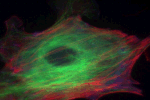Nanosurgery with femtosecond lasers
We have developed a technique to disrupt submicrometer-sized organelles within living cells or tissue without affecting the surrounding material or compromising viability of the cell or organism. When a femtosecond laser pulse is tightly focused into a nearly-transparent biological material, energy is deposited by nonlinear absorption only in the focus where laser intensity is high, resulting in disruption of the structure in the focal volume. Because the absorption is confined to the small focal volume, the surrounding material is unaffected, allowing micrometer precision in the disruption of biological tissue.
Subcellular surgery and nanosurgery,
at
Chemistry Seminar, Middle Tennessee University,
Friday, February 12, 2021
Photodisruption in turbid tissues with ultrashort laser pulses,
at
Photonics West 2000 (San Jose, CA),
Tuesday, January 25, 2000:
Sub-cellular nanosurgery in live cells using ultrashort laser pulses,
at
Photonics West 2006 (San Jose, CA),
Sunday, January 22, 2006:
Subcellular surgery and nanosurgery,
at
Baetjer Colloquium, Princeton University (Princeton, NJ),
Friday, November 16, 2007:
Subcellular surgery and nanosurgery,
at
University of Missouri St. Louis (St. Louis, MO),
Wednesday, March 9, 2011:
Sub-cellular femtosecond laser ablation,
at
2005 SPIE Photonics West Conference (San Jose, CA),
Wednesday, January 26, 2005:
Subcellular surgery and nanosurgery,
at
Shanghai Jiao Tong University (Shanghai, China),
Tuesday, March 27, 2007:
Nanosurgery with Femtosecond Lasers,
at
2009 OSA Frontiers in Optics (San Jose, CA),
Wednesday, October 14, 2009:
Subcellular surgery and nanosurgery,
at
Biophysics Colloquium, Elon University (Elon, NC),
Friday, October 16, 2015:
Photodisruption in biological samples using femtosecond laser pules,
at
MRSEC site visit, Harvard University (Cambridge, MA),
Wednesday, February 21, 2001:
Subcellular surgery and nanosurgery,
at
Sigma Pi Sigma Colloquium, University of Connecticut (Storrs, CT),
Friday, April 28, 2006:
Subcellular surgery and nanosurgery,
at
SPS Lunch Seminar, Yale University (New Haven, CT),
Wednesday, April 23, 2008:
Subcellular surgery and nanosurgery,
at
32nd Puerto Rico Interdisciplinary Scientific Meeting, University of Puerto Rico Carolina (Carolina, PR),
Saturday, March 10, 2012:
Design, simulation, and fabrication of plasmonic pyramid substrate for cell transfection,
at
Photonics West LASE 2015 (San Francisco, USA),
Sunday, February 8, 2015:
 The detailed architecture of spindle microtubules, involved in cell division, was revealed using femtosecond laser nanosurgery. This work was performed in collaboration with the Needleman group (results published in Cell).
The detailed architecture of spindle microtubules, involved in cell division, was revealed using femtosecond laser nanosurgery. This work was performed in collaboration with the Needleman group (results published in Cell).